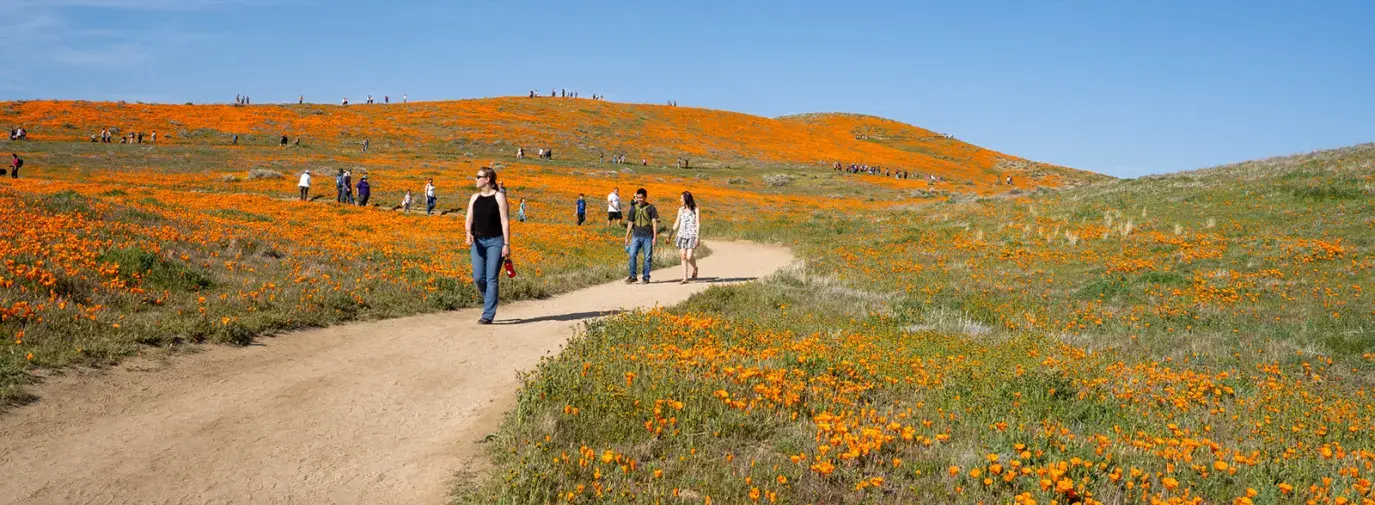
Explosions of poppy flowers color the countryside of California in vibrant shades of gold and orange, signaling the end of long nights and the start of warmer days. Butterflies and people alike respond to the arrival of spring by visiting the blooming hills—but only one is trampling the sights.
This is the image of the 2019 California poppy “super bloom.” Yet, instead of being popular for its beauty, it’s infamous for the people destroying it for the perfect selfie. Many uninformed visitors have trampled vegetation by walking off-trail, leaving behind dead flowers and compacted soil. This isn’t the first time natural places have witnessed harmful human activity—parks including the delicate Joshua Tree National Park experienced vandalism and waste overflow during the government shutdown earlier this year.
Whether you’re heading out on a hike or paddle this summer, remember these guidelines to reduce your impact on our precious parks.
Follow Leave No Trace Outdoor Ethics
Whether you are a seasoned outdoor recreationalist or an occasional visitor, you have likely heard of “Leave No Trace.” It is a collection of principles that serve to educate visitors in minimum-impact practices based on extensive research on human impacts and attitudes towards the outdoors. These range from minimizing campfire debris to being considerate of other visitors. While the phrase itself is a mantra for seasoned outdoor enthusiasts, Mitch Warnick of the Leave No Trace Center says it’s meant for everyone.
“We can treat Yosemite National Park the same as Piedmont Park in Atlanta,” Warnick says. “They’re both public lands, open space that are a valuable natural resource. Everyone can benefit from understanding Leave No Trace principles.”
Pack it In, Pack it Out
Don’t leave behind litter when visiting any public land. Many locations have bathrooms and disposal bins, but you may have to bring bags with you when visiting more remote areas. While micro-trash (cigarette butts, fishing line, wrapper scraps) is easy to overlook, it is dangerous to wildlife that may confuse it for food.
It might seem like leaving biodegradable items behind could be an exception to this rule. Unfortunately, most things labeled as biodegradable or compostable are missing one important word: “commercially.” Many of these items can only be broken down in commercial composting facilities—throwing them into your backyard compost or leaving them at a park doesn’t mean they will break down on their own. Even items that are naturally biodegradable such as orange peels cannot be left behind. Essentially, if it is not natively found in the park you’re visiting, it does not belong there. This is critically important for popular parks that see thousands of visitors each year.
“There’s certainly a notion that with many people, their impact is very small,” Warnick says. “But if a thousand other people do that, then it starts to become fairly problematic and can have a large impact.”
Stay on the Trail
Going off trail compacts the earth and creates a new “social” trail. Social trails are tracks that others follow thinking it is a legitimate path; however, they can affect how water flows during a rain and wash out a previously safe part of the original trail. In particularly fragile places, going off trail means trampling delicate keystone species like cryptobiotic soil (a fungi “crust” that prevents desert erosion). Stay on the trail even when it means going through a muddy section—going around will only widen the trail.
Established trails are designed to have a minimal impact and are regularly maintained by park staff for safety and cleanliness.
Allyship in the Outdoors
Public lands are for everyone, but not everyone enjoys them. A 2012 study titled “Why Do So Few Minority People Visit National Parks?” found that Asian Americans, African Americans, and Hispanic populations often feel uncomfortable when visiting parks.
Historically, federal public lands have played a role in promoting racial segregation and suppressing indigenous rights. The latter struggle is yet ongoing.
Inclusion-minded Green Americans can take part of forging a new path by inquiring about park diversity, equity, and inclusion policies, sharing concerns with park officials and state legislatures, and supporting projects that work to make the outdoors more inclusive like Diversify Outdoors and Camp OUTdoors. These recommendations come from a diverse group of outdoors experts from a partnership between The Atlantic and REI.
Inclusion is a crucial part of outdoor advocacy—conservationists are born when a new visitor falls in love with the outdoors.
When Visiting Public Lands, Don’t “Do It for the Gram”
Summer means nature is in full bloom—and so are everyone’s Instagram feeds.
Being kind to public lands also means respecting them online. While social media has served to share the beauty of natural places, it has simultaneously made them more popular. That popularity has led to an influx of visitors many fragile places are unable to accommodate.
Hanging Lake in Colorado is a famous photo destination and a prime example of the effect of damaging human activity. In four years, visitation has doubled, and many of those visitors disregarded the National Forest’s rules for the sake of a perfect photo. As a result, management was forced to move to a permit system. Visitors must now purchase a hiking permit in advance, so rangers know who is on the trails and can hold them accountable to illegal activities such as walking off trail and swimming in the water.
To protect public lands, visitors can combat harmful social media practices by not geotagging specific locations and sharing ecosystem-kind practices to those who ask. Additionally, not sharing photos that promote illegal activity (including but not limited to: walking off trail, drone shots in no-fly zones, feeding animals) will safeguard public lands for future visitors.
Volunteer
Park clean ups are a great introduction to outdoor stewardship for children and are hosted by local community associations and environmental organizations. You can find a clean-up near you with volunteercleanup.org and americanrivers.org. Volunteer opportunities with the US Fish and Wildlife Service, such as tagging butterflies and planting native trees, may be found at wildlife refuges and hatcheries across the country. Visit volunteer.gov to learn more.
Clean-ups and local conservation projects aren’t the only way to get involved. Green America, among other nonprofits, leads campaigns in support of or against environmental policies. Signing petitions, volunteering on these campaigns, and showing up to rallies are additional ways to promote outdoor stewardship on the civic level.
Become an Advocate
The outdoors does not speak for itself in court rooms or legislative offices. We do. Therefore, the most valuable way to protect our public lands is to advocate for them. The damage to public lands during the government shutdown was a tough lesson on the importance of park management. Changes such as better infrastructure, holistic park management, and more funding are all items advocacy can support.
Not sure how to get involved? Outdoor Alliance is a coalition of national advocacy organizations that provides resources on the latest public land and conservation policies—their Advocacy 101 Series is an easy introductory toolkit for the novice conservationist.
Most importantly, vote. Advocacy can only go so far if our elected officials don’t serve conservation. You can learn how to register to vote at vote.gov and learn who your elected representatives are at commoncause.org and click “find your representative.”
“Public lands are important, whether that’s for ecological reasons, or recreation,” says Warnick. “It’s all of our collective duty to protect them.”







